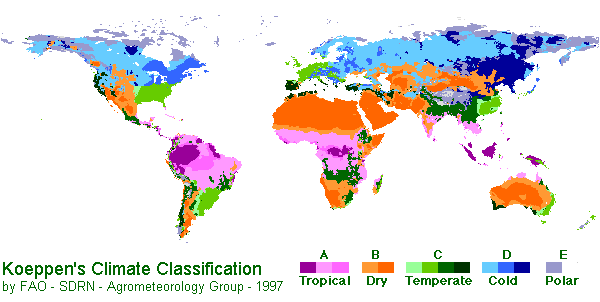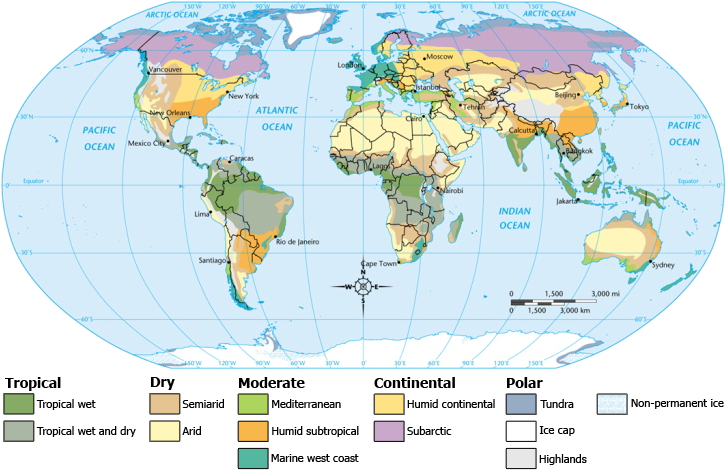Weather and Climate
World climates are typically divided into 5 big areas: tropical, dry, mid-latitude, high latitude, and highland. The areas are divided into smaller subregions that are described listed below. This subregion has little variation in temperature level over the yearit is constantly hot, with a typical temperature of 80F. The days start warm however by afternoon have actually clouded up, and rain falls nearly day-to-day. The average quantity of rain in a year is more than 80 inches. Tropical damp environments are discovered in Central and South America as well as Africa and Southwest Asia. This climate is called “tropical damp and dry” since the subregion has a rainy season in summer season and a dry season in winter.
Rainfall is less than in the tropical wet climate subregion and happens mostly in the damp season. Tropical damp and dry environments are discovered next to tropical damp climates in Africa, South and Central America, and parts of Asia. This environment subregion does receive rainfall, simply not quite: about 16 inches each year. Summertimes are hot. Winters are mild to cold, and some semiarid locations can produce snow. The environment is found in the interior of continents, or in a zone around deserts. The area contains some of the most productive agricultural lands in the world. Some individuals believe a desert is absolutely nothing but sand dunes.
Deserts get less than 10 inches of rain per year. Hot deserts, like the Sahara and the Arabian Desert, regularly have low humidity and high temperature levels throughout the day. During the night, temperatures drop since the dry air can not hold heat well. Cool/cold deserts are discovered in the mid-latitudes mainly in the Northern Hemisphere, frequently in the rain shadow of nearby mountain ranges. Summer season temperature levels are warm to hot, and winter temperatures vary from quite cool to below freezing. This environment subregion is called for the land around the Mediterranean Sea where it lies. It also exists elsewhere, such as the west coast of the United States and parts of Australia.
This environment area supports a thick population and abundant agricultural activity. This climate subregion, which lies close to the ocean, is regularly cloudy, foggy, and damp. The winds over the warm ocean moderate the temperatures and keep them relatively constant. Parts of the west coast of the United States and Canada and most of Western Europe experience this environment. Rainfall in marine west coast environment regions is equally dispersed throughout the year. Industrial areas with marine west coast climate might have smog (a mix of smoke and fog). Long periods of summer season heat and humidity characterize the humid subtropics.
The Main Principles Of Weather



The southeastern part of the United States and large areas of China are examples. Winters are mild to cool, depending upon latitude. The environment is extremely suitable for raising crops, especially rice. A terrific variety in temperature level and precipitation defines this environment, which is found in the mid-latitude interiors of Northern Hemisphere continents. For example, Winnipeg, Manitoba, in Canada lies deep in the North American continent. It has a humid continental environment. Air masses chilled by Arctic ice and snow flow south over these locations and regularly clash with tropical air masses, triggering altering weather condition conditions. These areas experience four seasons.
Evergreen forests called taiga cover the lands in the subarctic subregion, specifically in Canada and Russia. Big temperature level variations take place in this subregion in between summertime and winter. Although the summer seasons are short and cool, the winters are constantly extremely cold. Temperature levels at freezing or listed below freezing last five to 8 months of the year. The flat, treeless lands forming a ring around the Arctic Ocean are called tundra. The climate subregion is likewise called tundra. It is practically exclusively situated in the Northern Hemisphere. Very little precipitation falls here, usually less than 15 inches annually. The land has permafrostthat is, the subsoil is continuously frozen.
Snow, ice, and permanently freezing temperatures define the region, which is so cold that it hardly ever snows. These subregions are sometimes called polar deserts since they get less than 10 inches of rainfall a year. The coldest temperature level ever recorded, 128. 6F below absolutely no, was on the ice cap at Vostok, Antarctica. The highlands climate varies with latitude, elevation, other topography, and continental area. In rugged mountain locations such as the Andes of South America, environments can vary based on such factors as whether a slope faces north or south and whether it is exposed to winds carrying moisture. Comprehending environment assists you comprehend about the basic climate condition in a location.
Related:
Leave a Reply